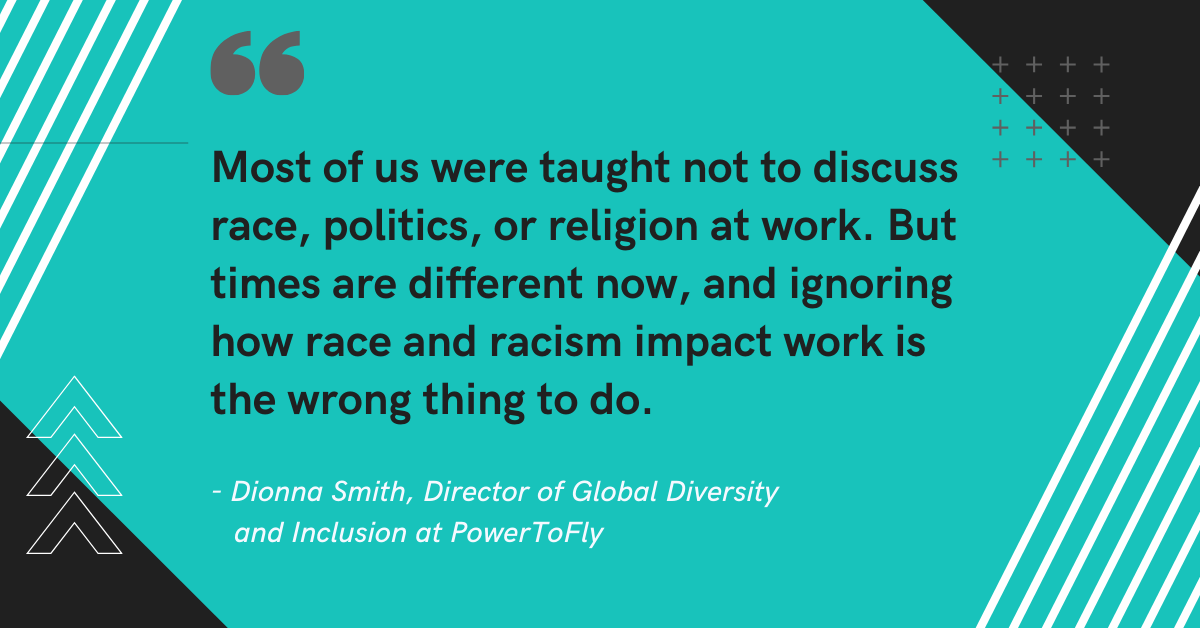The world has changed in the past few weeks.
We're watching corporations and organizations across the world come out in support of Black lives in droves. Many of those organizations are doing so for the first time in their history.
But supporting Black people goes beyond sharing a mission statement or putting out a press release. It requires dedicated, ongoing work and resources.
As leaders in the Diversity and Inclusion space, PowerToFly has been getting questions from business leaders on what else they can do. How can they make Black employees feel supported at work? What kind of analysis should they be doing on their own processes and policies to root out systematic racism they may be perpetuating? And how can they keep these conversations about race and racism going even after the media coverage has died down?
A few weeks ago, in my role as PowerToFly's Director of Global Diversity and Inclusion, I held a chat-and-learn two weeks ago focused on how individuals could be better allies to their Black colleagues and friends. (You can watch a recording of our conversation here and read my summary of takeaways here.) Two weeks ago, I held another webinar, this time focused specifically on what leaders—whether CEOs, executives, HR managers, or frontline team leads—can do to support their Black employees. You can watch a replay or read on for my summary of key points and advice on the subject.
A reminder: none of what's going on right now is a Black problem. This is an American problem and even a global problem. Black people cannot end systematic racism or white supremacy, and we need white Americans and other allies to work together to end it. We need everyone in the boat with us, rowing together, if we're to see any real change. I know that fighting for that change isn't always comfortable or easy, but it's vital that we do it. It's especially important that all of you leaders, who have seats at the table to change policy and be actively anti-racist in your organizations, do it.
Thank you for joining the fight.
A five-step framework for addressing systematic racism at work
Most of us were taught not to discuss race, politics, or religion at work. But times are different now, and ignoring how race and racism impact work is the wrong thing to do. It's vital to address racism in the workplace not just for your employees, but also for the general public, who are noticing which companies are speaking up for what's right and which companies aren't. It'll be increasingly important in the future for leaders to commit to this change as workers and consumers alike seek to align themselves with organizations that share their values.
To aid you as you start doing that work, here are five steps you can take to start addressing racism at the workplace.
1. Get comfortable with having candid conversations about race.
There's no such thing as being colorblind. Saying so is problematic. We can't address the things that need to be fixed if we don't see color. Start by acknowledging that there are certain groups of people who are treated differently or haven't had the same opportunities. Start by accepting that you don't have all (or even any) of the answers, but that you're committed to working towards them.
2. Do regular, mandatory training on inclusivity, sensitivity, and other race-related topics.
Most workplaces have certain courses that are required, at least for managers and leaders, like sexual harassment courses or compliance training. If you want to make it clear that race is important and that racism won't be tolerated at your workplace, you need to invest in mandatory inclusivity training.
It has to be more than just a check-the-box activity. Your approach can't be, "Oh, everybody took unconscious bias training, we're good to go."
Just like anything else in your business that you really care about, you'll need to devote money and time to actively dismantling systematic oppression. That looks like monthly or quarterly workshops, having a speaker series where you invite SMEs to take on diversity topics, and investing in a D&I leader or in a resource group and partnering with them to regularly train and educate your workforce.
3. Address systemic issues in how you hire, pay, and promote employees.
A Black Lives Matter press statement is necessary but not sufficient when it comes to addressing racism at your company. It's a great first step, but if you don't start addressing and making changes beyond the company values section of your website, it's all for naught.
Start by looking at your salaries. Is there equity in what you're paying Black employees compared to white employees? Don't assume that there is without taking the time to analyze the situation.
Do the same for employee promotion rates. Who is moving up into bigger management jobs—and who isn't?
Look at project allocation, too. Are the same people getting the same chances to appear and present in front of executives? Are your Black employees getting opportunities to work on stretch projects?
Once you understand where the inequities are in your business, address them. These issues have deep-rooted causes and won't go away overnight. You'll need to come up with an action plan and start working against it.
4. Review your employee referral program.
While employee referral programs can be great, they are often not the best way to attract diverse candidates. If you have a mostly male white workforce, then your employee referrals are going to reflect that. The majority of companies don't have diverse workforces, which warrants a closer look at how these programs are implemented.
Consider running specialized referral programs through employee resource groups for underrepresented minorities. If you have a Black or Latinx group, for instance, work with your HR or Recruiting teams to source referrals from those pools.
5. Create executive sponsorship opportunities for Black employees.
Sponsors can make or break a career path. They can fast-track someone to a leadership role, create opportunities, and give an employee cover to try something new. But if Black employees haven't had a chance to get in front of executives—if they aren't playing golf with them, going out to dinners and lunches with them, or working with them on high-priority projects—they won't get those benefits. Add an explicit diversity focus to current sponsorship initiatives, and if none exist, create them in partnership with ERGs.
Tips and guidance to inform your approach
In implementing the above five steps, you may find yourself feeling unsure or uncomfortable. That's natural, especially if discussing race is something you haven't done before. Remember that to do this work well, you need to be willing to listen and to learn. Below, I've provided answers to some community-sourced questions on how exactly to do that.
How can I navigate a conversation with Black employees in a way that makes them feel supported?
As business and HR leaders, you might be wired to be very solution-oriented and to want to fix things for your employees. But you can't immediately fix racism or fix an employee's experience with it at work.
When talking about race with employees, do not make it about you. If an employee is talking to you about what they're feeling or going through, you can say things like, "I'm so sorry you're going through that" or "I hate that you're feeling that way" or "I care about you." Do not say "I know what you're going through" if you don't. Do not apologize on behalf of the white race or in any other way make it about what you're feeling, whether that's guilt or frustration or anything else. Just listen.
How can I—or should I—check on Black employees without disrupting their privacy?
Keep in mind that Black people have been taught to assimilate and blend in as much as possible, especially at work. Being called out at work specifically for being Black is not going to be a comfortable thing for many people. Do not zero in on the one Black person on your team in a meeting, for instance, and ask them how they're doing with everything that's going on.
If you are going to do a check-in, do it in a one-on-one setting. Give your employee an opportunity to give you cues. Are they bringing up what's happening in the news? Are they sharing that they went to a protest? If not, maybe they don't want to talk about it.
If you decide to check in anyway, don't direct the conversation. Tell them that you're there to help if they want to talk and that you want to know how they're feeling. But if they don't want to engage, let it go. Remember, this is not about you and what you think you need to do to be a good or inclusive leader. This is about your Black employees and what they are feeling.
How can I address colleagues who have implied or explicitly stated that they are not allies?
Be conscious of your energy. There are policies to create at work. There are protests to attend in your neighborhood. There are kids to raise and jobs to do. Investing time in someone who does not care or opposes who you are or what you believe in is not good for you, so minimize those debates and focus on what you can change.
That being said, don't change your message to make people comfortable. Now is a time to take a stance. If your colleagues aren't willing to do that, it might be time to leave them behind.
How can a primarily white team or organization support the Black community right now, especially if financial levers like expanding hiring aren't available?
It's important to move towards creating a more equitable workplace and culture even if you don't have a Black employee on your team. It's the right thing to do. Remember that allyship is essential, and that white allies can have huge influence within organizations and communities. So start with the five steps above. If you have a budget beyond that, invest it in additional D&I training. Provide resources for doing anti-racist work in-house. Dedicate time every week in your team meeting to talk on topics relevant to the Black Lives Matter movement, whether that's defining what being an ally is, learning about systemic oppression, or brainstorming ways to get involved in your local community.
How can I use levers to make sure my internal and external recruiting is as diverse as possible without being discriminatory?
First of all, there's nothing discriminatory about asking for a diverse slate of candidates, whether you're asking an external recruiter or an internal team. You're not promising anyone a job based on their identity; you just want to make an effort to see a range of candidates. Hiring diversely doesn't happen by chance. You don't post a job and then just see a flood of resumes that perfectly represent all races and identities. That's called the "post and pray" approach and it's destined to fail.
If you're hiring internally, start by going to employee groups and encouraging group members to apply. Ask if they have anyone they'd recommend for the position. Make an effort to ensure that people know about open opportunities and what you're looking for.
If you have a recruiter or sourcer working with you, tell them that you want to look at a diverse pool of candidates.
Going forward
These are tough subjects to tackle and doing so will require sustained focus and resources. Thank you for doing this work. If there's anything we at PowerToFly can do to help as you continue down the path towards becoming an actively anti-racist organization, please feel free to reach out to me and my team at answers@powertofly.com!




